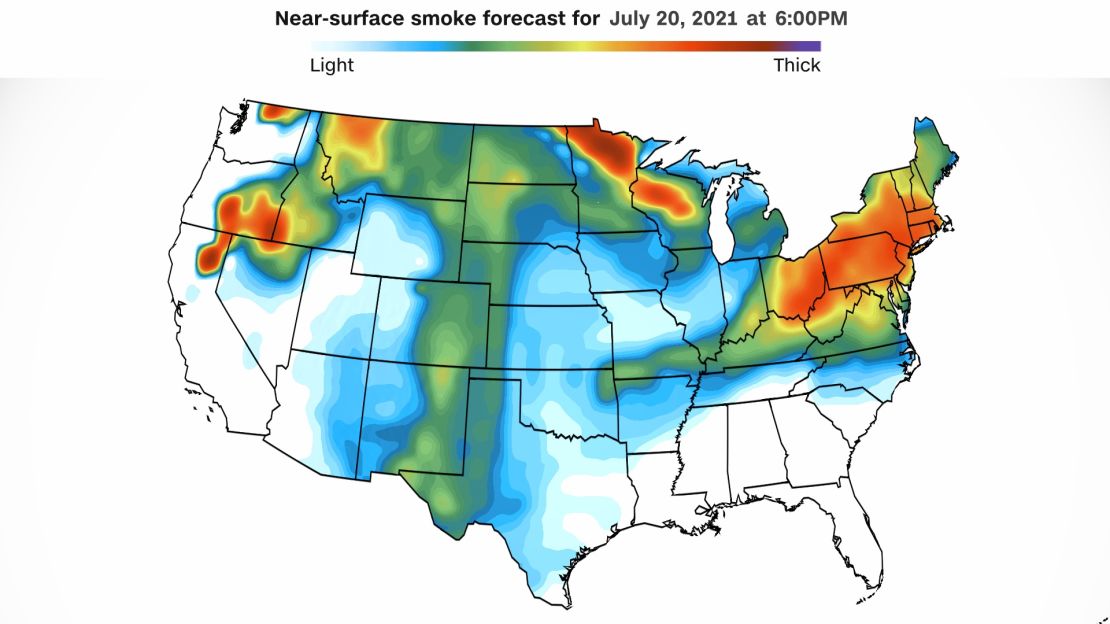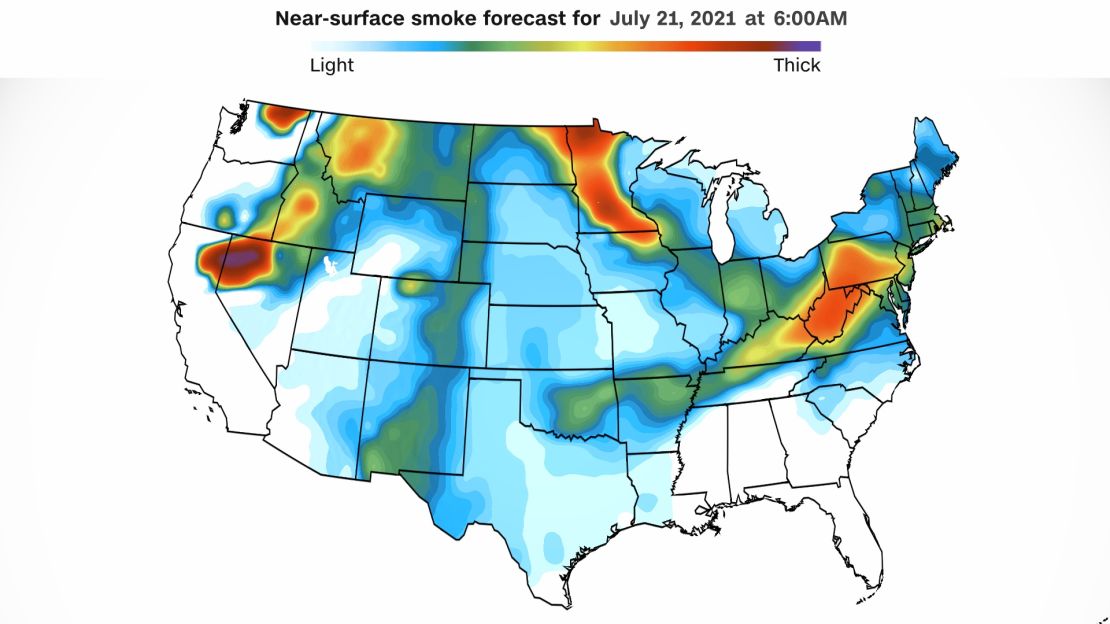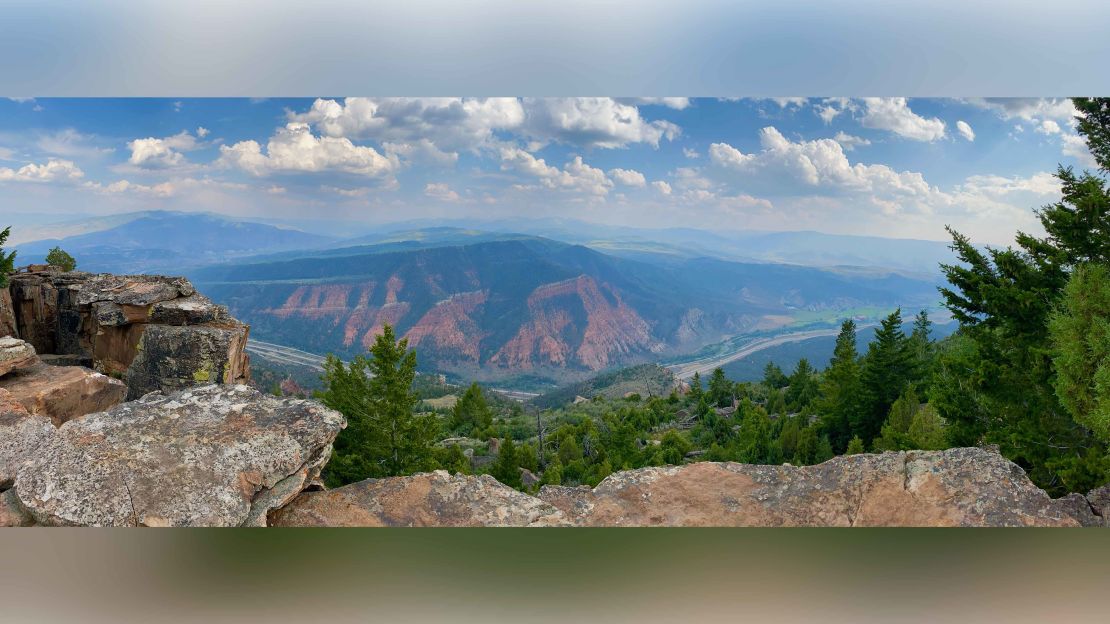The massive Bootleg Fire in Oregon has scorched an area larger than Los Angeles, and it’s only 30% contained. The fire is so large and is burning so hot that it’s creating its own weather.
It’s just one of the many blazes raging in the West; the National Interagency Fire Center is watching 80 large fires across 13 states this week – a testament to just how destructive the US wildfire season has become.
And the effects of the fires stretch all the way to the East Coast.
Extraordinary plumes of wildfire smoke are billowing out of these massive complexes, reaching so far up into the atmosphere that they are being carried thousands of miles east by high-level winds.
While heavy smoke is making air quality hazardous in the West, it’s also creating eerie skies over the Midwest and Northeast.
All of the ingredients are in place for a exceptionally dangerous season – historic drought, extreme heat in early summer and a snow drought exacerbated by a dry winter and hot spring.
Eerie scenes in the East
Even as fog cleared Tuesday morning around the Great Lakes and along the East Coast, it was still hard to find sunshine as a thick blanket of wildfire haze hung in the sky.
“In areas where skies are ‘clear,’ thick smoke aloft is limiting sunshine, with no discernible sunrise visible at our office earlier this morning despite practically clear skies!” wrote the National Weather Service office in Albany, New York.
There were few clouds in the Northeast on Tuesday morning, but the smoke – carried on a 3,000-mile trip across the country – created a hazy start to the day.
In some areas, the smoke has reached the ground level, where it can be a health concern. Air quality alerts have been issued hundreds of miles from the flames, as far east as Pennsylvania and New York.
“Wildfire smoke should reach its peak concentration over Pennsylvania on Tuesday afternoon and some near surface smoke may also contribute to another day of hazy conditions” the National Weather Service in State College, Pennsylvania, predicted.
Large wildfires in Canada have produced massive amounts of smoke as well, prompting air quality alerts in areas of Minnesota and North Dakota. “Smoke from wildfires located north of the Canadian border in Ontario and Manitoba will be transported by northerly winds behind a front moving into the northern portions of the state,” said National Weather Service meteorologists in North Dakota.
On Tuesday evening, the heaviest concentrations of near-surface smoke are expected in the Northwest, where the fires are burning, the Upper Midwest and the Northeast. There’s also a plume of moderate smoke that stretches from the Northern Plains south into Texas and New Mexico.

Conditions improve slightly on Wednesday in the Central US and the Northeast as a cold front pushes smoke into West Virginia and Pennsylvania.
Smoke particles can prove dangerous to young children and to those who have preexisting cardiopulmonary illnesses such as asthma and heart disease. Air quality alerts are issued when the health impacts are heightened due to air pollution, in this case from wildfire smoke.
Nearly the entire state of New York was under an air quality alert Tuesday.

The smoke at high levels of the atmosphere is visible in several ways. Its effect on light causes the sun to look red at sunset as the sky takes on a burnt-orange color. A similar effect can be seen in the morning as the sun rises.
This happens because of the way light passes through the atmosphere. Sunlight is scattered in all directions by small air particles and the smallest wavelengths – the blues – are scattered the most, which is why the sky is blue.
Smoke particles are much larger, scattering the red wavelengths more efficiently and causing the sky to take on a yellow or orange tint.
Impact of drought
Wildfires have devoured more than 1.2 million acres of drought-stricken land so far this season.
“Seven fuels and fire behavior advisories have been issued for south/central Idaho, Northern California, Northern Rockies, and south/central Oregon. Many of these advisories describe extraordinarily dry fuels, resulting in elevated fire potential and fire activity,” said the National Interagency Fire Center.
California alone has recorded more than 5,000 fires that have burned more than 200,000 acres so far this year – five times more acreage burned compared to the same time last year. Drought, heat and wind are the worst possible combination for wildfires, and explosive fire behavior is launching smoke high into the atmosphere.

CNN meteorologist Chad Myers experienced the otherworldly phenomenon wildfire smoke creates.
“Last week I spent time in the Vail Valley of Colorado. It takes my breath away each time I visit. This time was different. No blue sky, no stars above, and a faint smell of smoke,” Myers recounted.
Colorado has seen four of its top five largest wildfires in the last three years, in 2018 and 2020 during the record-breaking wildfire season nationwide. Wildfire smoke frequently rests on the foothills of the Rockies during the summertime which makes outdoor activities more of a health risk.
Residents in the state are accustomed to the idea of a having a perpetually packed suitcase carrying important documents, family memories and medical needs during the summer months – a “go bag” – in the event that they need to evacuate quickly because of an approaching fire.
“It was startling, to say the least, waking up to the smell of smoke, said Myers, who called it “unnerving, especially in the mountains, because it means you are downwind of something on fire.”
Those on the East Coast may not have a “go bag” prepped and ready to evacuate at a moments notice, but an air quality alert on a smart phone or the blazing red sunset is a visual reminder of the nationwide struggle to conquer the seemingly insatiable infernos in the West.




